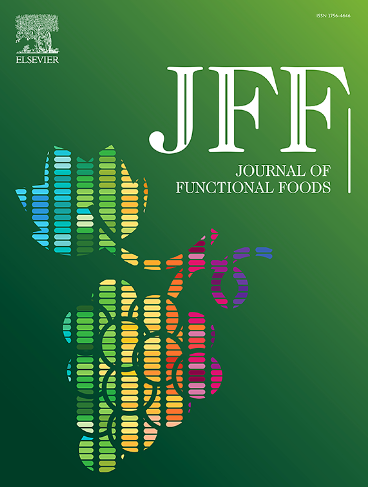揭示氨基酸序列特征,赋予高钙结合能力的大豆肽和提高吸收在caco-2细胞
IF 3.8
2区 农林科学
Q2 FOOD SCIENCE & TECHNOLOGY
引用次数: 0
摘要
食源性肽的构效关系是营养物质相互作用研究的热点。一些研究还提高了这些螯合剂促进钙吸收的能力。然而,使钙结合的结构是否也影响吸收还没有详细的研究。我们前期的研究发现,结构特征,如天冬氨酸靠近n端中心或连续的天冬氨酸,增强了肽钙结合能力。虽然GGDLVS肽具有这些特征,但其对钙吸收的影响尚不清楚。本研究调查了从具有或不具有这些结构的肽衍生的螯合物。结果表明,具有该结构的螯合物更有效地促进Caco-2细胞钙吸收,上调钙通道蛋白TRPV6的表达。分子对接表明,该结构促进蛋白质相互作用,促进钙在通道入口积聚。分子动力学模拟表明,螯合结构促进了蛋白质的活化,稳定了构象,并增加了随后的氢键形成。本文章由计算机程序翻译,如有差异,请以英文原文为准。

Unraveling amino acid sequence features that confer high calcium-binding capacity to soybean peptides and improve absorption in caco-2 cells
Structure–activity relationship of food-derived peptides is a hotspot for nutrient interactions. Some studies have also improved the ability of these chelates to promote calcium absorption. However, whether the structures enabling calcium binding also influence absorption has not been studied in detail. Our previous research found that structural features, such as aspartic acid near the center of the N-terminal or consecutive aspartic acids, enhancing peptide calcium-binding capacity. Although the GGDLVS peptide exhibits these features, its effect on calcium absorption remains unclear. This study investigated chelates derived from peptides with or without these structures. The results indicated that chelates with this structure more effectively promoted Caco-2 cell calcium absorption and upregulated calcium channel protein TRPV6 expression. Molecular docking showed that the structure promoted protein interaction, facilitating calcium accumulation at the channel entry. Molecular dynamics simulations showed that the chelate structure promoted protein activation, stabilized conformation, and increased subsequent hydrogen bond formation.
求助全文
通过发布文献求助,成功后即可免费获取论文全文。
去求助
来源期刊

Journal of Functional Foods
FOOD SCIENCE & TECHNOLOGY-
CiteScore
9.60
自引率
1.80%
发文量
428
审稿时长
76 days
期刊介绍:
Journal of Functional Foods continues with the same aims and scope, editorial team, submission system and rigorous peer review. We give authors the possibility to publish their top-quality papers in a well-established leading journal in the food and nutrition fields. The Journal will keep its rigorous criteria to screen high impact research addressing relevant scientific topics and performed by sound methodologies.
The Journal of Functional Foods aims to bring together the results of fundamental and applied research into healthy foods and biologically active food ingredients.
The Journal is centered in the specific area at the boundaries among food technology, nutrition and health welcoming papers having a good interdisciplinary approach. The Journal will cover the fields of plant bioactives; dietary fibre, probiotics; functional lipids; bioactive peptides; vitamins, minerals and botanicals and other dietary supplements. Nutritional and technological aspects related to the development of functional foods and beverages are of core interest to the journal. Experimental works dealing with food digestion, bioavailability of food bioactives and on the mechanisms by which foods and their components are able to modulate physiological parameters connected with disease prevention are of particular interest as well as those dealing with personalized nutrition and nutritional needs in pathological subjects.
 求助内容:
求助内容: 应助结果提醒方式:
应助结果提醒方式:


